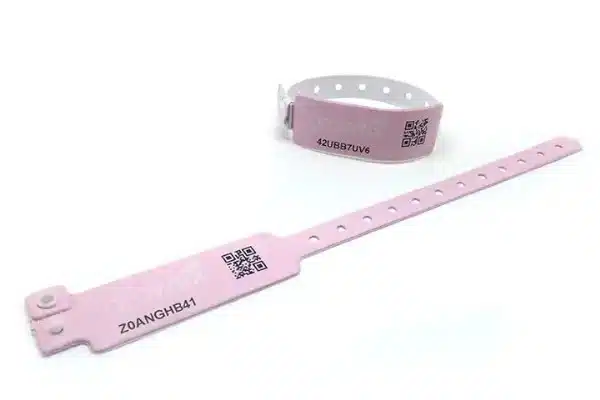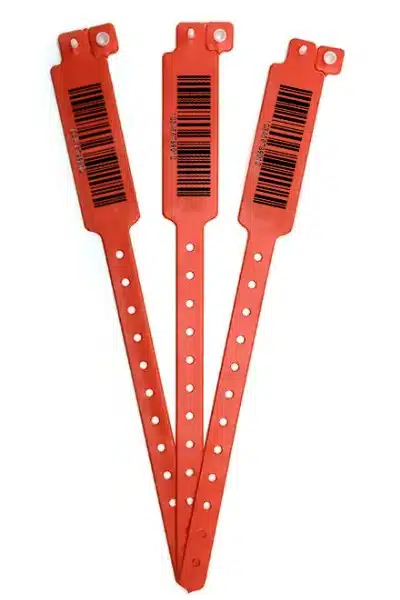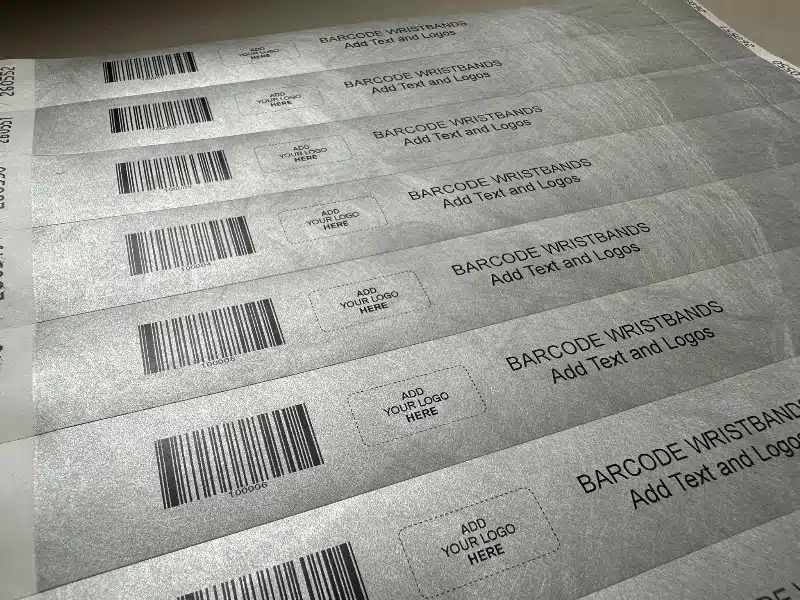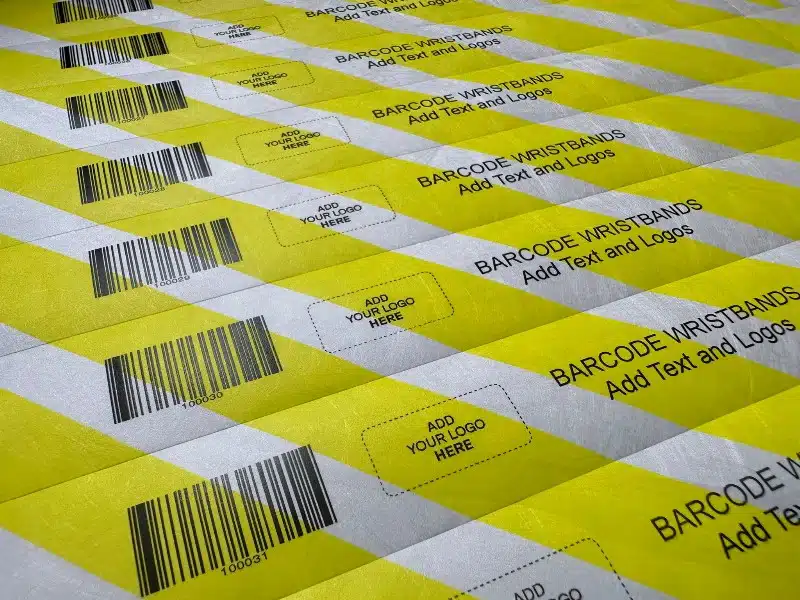Barcode Wristbands with variable data
Get Customized Wristbands with barcodes and serial numbers
Barcode wristbands have become increasingly common in various industries, providing a convenient and efficient way to manage data, enhance security, and streamline processes. Whether you encounter barcode wristbands at a healthcare facility, an event, or a retail store, knowing how to scan them is essential. In this comprehensive guide, we will explore the fundamentals of how to scan barcode wristbands, the technology behind it, and the diverse applications where it is used.
Before diving into the process of scanning and using these wristbands, it’s important to have a basic understanding of what they are and how they work.
What Are Barcode Wristbands? Barcode wristbands are wearable accessories, typically made of plastic or paper, that include a barcode on their surface. This barcode is a unique identifier that can be scanned using a barcode reader or scanner. The information encoded in the barcode may vary depending on the application, but it is often linked to a specific individual, product, or service.
How Do Barcode Wristbands Work? When a barcode wristband is created, a unique code is generated and printed on the wristband. This code can be alphanumeric and may vary in complexity depending on the requirements. To scan the barcode, a compatible barcode scanner is used. The scanner emits a light source that reads the barcode’s pattern, and this information is then decoded by the scanner and sent to a connected system for processing.
In our modern, fast-paced world, the need for efficient and accurate data management has become paramount. Barcode technology, which was first introduced in the 1940s, has since become an integral part of various industries, including retail, logistics, and healthcare. One of the innovations that have emerged in recent years is the barcode wristband. These unassuming wristbands have transformed the way we manage information, and here we explore their evolution, applications, and the future of barcode wristbands.
Barcode wristbands, also known as wristband barcode labels, are a relatively recent development in the world of data management. They gained popularity due to their convenience and versatility. In the early days, barcodes were primarily used for retail inventory management, but over time, their applications expanded, and wristbands emerged as a significant tool for a variety of purposes.
See below a pricing table for Barcode Wristbands
| Quantity | Price per band |
| 100-499 | 15c |
| 500-999 | 13.5c |
| 1,000-1,999 | 12c |
| 2,000-4,999 | 10.5c |
| 5,000-9,999 | 8.5c |
| 10,000-19,999 | 6.5c |
| 20,000 + | 5.5c |
One of the earliest applications of barcode wristbands was in access control. Event organizers and venues saw the potential for these wristbands to replace paper tickets and physical keys. Attendees could easily scan their wristbands to gain entry to concerts, sporting events, or even hotels. This not only reduced the risk of counterfeit tickets but also streamlined the entry process, making it faster and more secure.
Barcode wristbands also found a home in the realm of cashless payments at events and festivals. Instead of carrying cash or cards, attendees could load money onto their wristbands, which could then be used to purchase food, drinks, and merchandise with a simple scan. This made transactions quicker and more efficient, while also reducing the chances of theft or loss.
While the popular product made its mark in the world of entertainment and events, their most profound impact has been in healthcare. The use of barcode wristbands in healthcare has not only enhanced patient safety but also improved administrative processes.
Patient safety is a top priority in healthcare, and wristbands with barcodes and patient data have revolutionized patient identification. Each patient is assigned a unique barcode, which is printed on a wristband and linked to their medical records. Healthcare providers can easily scan the barcode to access the patient’s information, ensuring that the right treatment is administered to the right person.
Medication errors can have severe consequences in healthcare. Barcode bands are used to verify the correct medications and dosages before they are administered to a patient. When a nurse or caregiver scans the patient’s wristband and the medication’s barcode, the system cross-references the information and alerts if there is a potential error. This technology significantly reduces the risk of medication-related incidents.
-


Aqua Wristband – Buy Aqua Coloured Wristbands In Ireland
-

Custom Checked Blue Wristbands – Neon Blue Wristbands
-

Custom Checked Green Wristbands – Wristbands Available In Green
-

Custom Checked Orange Wristbands – Neon Orange Wristbands
-

Custom Checked Pink Wristbands – Neon Pink Wristbands
-

Plain Zebra Blue Wristbands
-

Plain Zebra Green Wristbands
-

Plain Zebra Orange Wristbands
-

Plain Zebra Pink Wristbands
-

Plain Zebra Red Wristbands
-

Plain Zebra Yellow Wristbands
-

Zebra Blue Wristbands
Future Prospects of Barcode Wristbands
As technology continues to advance, the future of barcode wristbands is brimming with possibilities. Here are some of the potential avenues for development and expansion:
Wristbands with variable data may soon incorporate more advanced security features, such as biometric authentication. This could provide an additional layer of protection for sensitive data, making them ideal for applications like access control and secure data management.
The Internet of Things (IoT) is transforming the way we interact with technology. In the future, barcode wristbands could integrate with IoT devices, allowing wearers to control various aspects of their environment through simple wristband scans. For instance, you might unlock your front door, adjust the thermostat, or make a payment, all with a swipe of your wrist.
In the wake of the COVID-19 pandemic, telemedicine and remote patient monitoring have surged in popularity. Barcode wristbands could play a vital role in these developments, enabling patients to monitor their health, access virtual consultations, and share critical health data with healthcare providers, all from the comfort of their own homes.
The move toward sustainability is a global trend, and barcode bands are no exception. Manufacturers are exploring eco-friendly materials and production methods to reduce their environmental impact. The ability to reuse or recycle barcode wristbands could become a selling point for various industries.
In today’s fast-paced world, barcode technology has become an integral part of our lives, enabling efficient data management across various industries. One of the innovative applications of barcodes is in the form of wristbands. Barcode wristbands, also known as wristband barcode labels, have seen a surge in popularity due to their versatility, convenience, and the multitude of purposes they serve. In this blog post, we will explore the diverse applications of wristbands that include variable data such as barcodes, shedding light on where they are used and how they are revolutionizing different sectors.
Healthcare Barcode Wristbands
One of the most critical and widespread applications of barcode bands is in the healthcare industry. The use of barcode wristbands in healthcare is primarily aimed at improving patient safety and streamlining administrative processes. Here’s how they are used in healthcare:
- Patient Identification: Barcode wristbands are used to ensure accurate patient identification. Each patient receives a wristband with a unique barcode that links to their medical records. Healthcare providers can scan the wristband to access the patient’s information, minimizing the risk of misidentification and ensuring that the right treatment is administered to the right individual.
- Medication Administration: Medication errors can have severe consequences. Barcoded tyvek or vinyl wristbands help in verifying the correct medications and dosages before administration. When a healthcare provider scans the patient’s wristband and the medication’s barcode, the system cross-references the information and alerts if there’s a potential error. This technology significantly reduces the risk of medication-related incidents.
- Access Control: Barcode wristbands are also used to manage access to secure areas in healthcare facilities, ensuring that only authorized personnel can enter restricted zones such as the operating rooms, pharmacy, or sensitive patient information areas.
- Allergies and Conditions: Barcode medical wristbands can include information about a patient’s allergies and pre-existing medical conditions, ensuring that healthcare providers are aware of any special considerations when providing care.
Access Control and Security
Barcode wristbands are increasingly being used in access control and security applications across various settings. Here’s where they find use:
- Corporate and Event Security: Barcode bands are used to control access to corporate facilities, conferences, and other private events. They provide a secure and efficient method of verifying the identity of attendees or employees.
- Amusement Parks and Attractions: Visitors to amusement parks, water parks, and other attractions often wear barcode wristbands that grant them access to rides and facilities. This not only enhances security but also reduces the likelihood of ticket loss or theft.
Hospitality and Accommodation
The hospitality and accommodation industry has embraced variable data wristbands for a range of applications. Here’s where they are used:
- Keyless Entry: Some hotels and resorts have replaced traditional key cards with barcode wristbands, allowing guests to unlock their rooms and access various amenities with a simple scan.
- Payment Convenience: Barcode wristbands can serve as a convenient method of making payments within the hotel or resort for services such as dining, spa treatments, or recreational activities.
- Identification: Wristbands can also serve as identification for all-inclusive packages at resorts, ensuring that guests receive the appropriate services without the need for traditional room keys or credit cards.
Barcode wristbands have made significant inroads in the world of entertainment and events, transforming the way we experience concerts, festivals, and sporting events. Here’s where barcode wristbands are used in this context:
- Access Control: Traditional paper tickets and physical passes are being replaced with barcode wristbands. Attendees can scan their wristbands to gain entry to events. This not only reduces the risk of counterfeit tickets but also streamlines the entry process, making it faster and more secure.
- Cashless Payments: Barcode wristbands enable cashless payments at events and festivals. Instead of carrying cash or cards, attendees can load money onto their wristbands, which can then be used to purchase food, drinks, and merchandise with a simple scan. This enhances the efficiency of transactions and reduces the chances of theft or loss.
- Crowd Management: Event organizers can use barcode wristbands to monitor attendance, control access to specific areas within the venue, and implement age restrictions or other security measures seamlessly.
Barcode Wristbands for Retail and Inventory Management
Barcode wristbands are also employed in the retail sector, especially in inventory management and sales tracking. Here’s where they are used:
- Inventory Control: Retailers use barcode wristbands to track inventory. Each item or batch of products can be assigned a unique barcode that is scanned when items are received, moved within the store, or sold to customers. This aids in maintaining accurate stock levels and reducing shrinkage.
- Price Labeling: Barcode wristbands are used for price labeling. Instead of attaching individual price tags to each item, retailers can use barcode wristbands to display pricing information, making it easier to update prices and manage sales promotions.
- Customer Loyalty Programs: Retailers may issue barcode wristbands as part of customer loyalty programs. These wristbands can be scanned at the point of sale to apply discounts, track purchases, or accumulate rewards points.
Transportation and Logistics
In the transportation and logistics sector, barcode wristbands play a vital role in managing goods and ensuring their secure and efficient movement. Here’s where they are used:
- Baggage and Cargo Tracking: Airlines, courier services, and shipping companies use barcode wristbands to track baggage and cargo. Each piece is tagged with a wristband containing a unique barcode that can be scanned at various checkpoints along the journey, ensuring accurate tracking and delivery.
- Boarding Passes: Airlines have adopted barcode wristbands as boarding passes, allowing passengers to check in and board flights with a simple scan. This has streamlined the check-in process and reduced the reliance on paper boarding passes.
- Inventory and Asset Management: Logistics companies use barcode wristbands to manage inventory and track the location of assets within warehouses and during transit. This helps in optimizing storage and distribution processes.
Educational Institutions and Barcode Wristbands
Barcode wristbands are finding their way into educational institutions for a variety of purposes. Here’s where they are used:
- Student Identification: Barcode wristbands serve as student identification cards, enabling access to campus facilities, libraries, and meal plans.
- Library Management: In libraries, students can borrow books and resources by scanning their wristbands, simplifying the borrowing and return process.
- Attendance Tracking: Some schools use barcode wristbands to track attendance in classrooms or during school events.
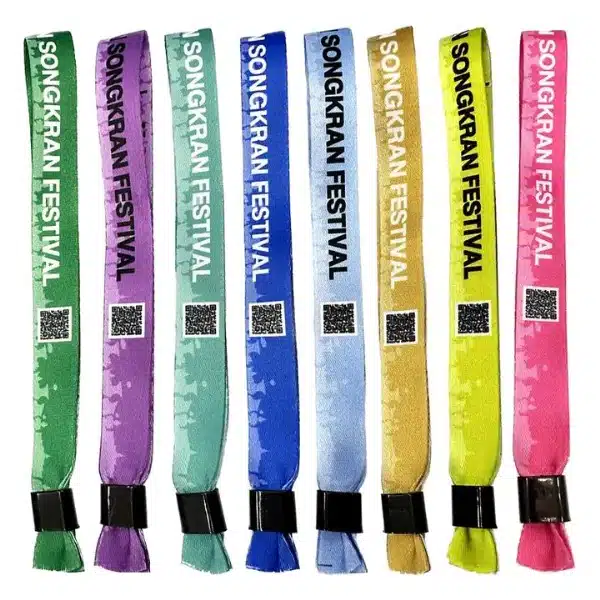
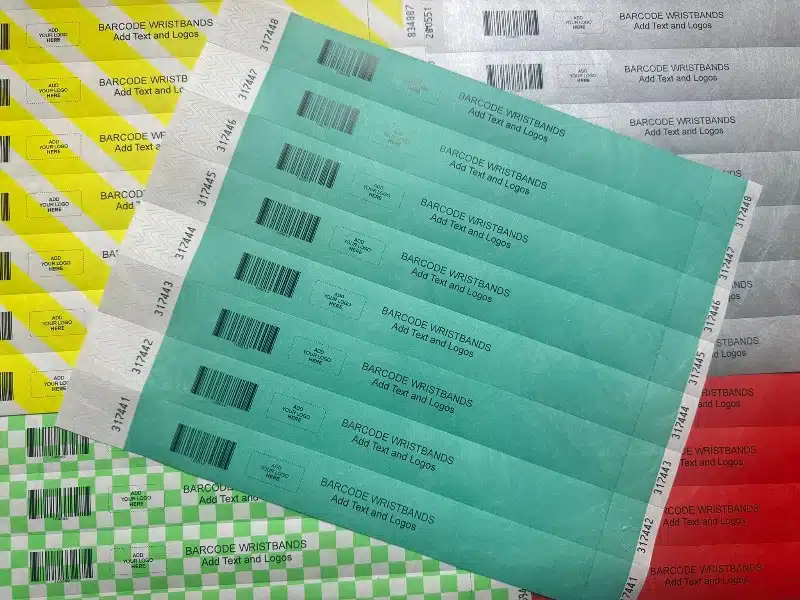
The Technology Behind Barcode Wristbands scanning
Scanning barcode wristbands involves the use of technology that reads and interprets the information encoded in the barcode. There are different types of barcode scanning technologies, and the choice of technology depends on the type of barcode and the specific application. Here are some common technologies used for scanning barcode wristbands:
- Laser Scanners: Laser scanners are one of the most common types of barcode scanners. They use a laser beam to read the barcode’s pattern. Laser scanners are known for their speed and accuracy, making them ideal for applications where quick scanning is crucial.
- Imager Scanners: Imager scanners use a camera-like device to capture an image of the barcode and then decode it using image processing software. They are versatile and can read barcodes in various orientations, making them suitable for scanning barcode wristbands on irregular surfaces.
- 2D Scanners: 2D scanners, also known as area imagers, are capable of reading 2D barcodes, such as QR codes. They are used in applications where additional information, like a web link or contact details, is encoded in the barcode.
- Mobile Apps: With the advent of smartphones, many mobile applications can turn a smartphone into a barcode scanner. These apps use the smartphone’s built-in camera to capture the barcode and decode it. This is particularly useful for personal use and in situations where dedicated barcode scanners are not available.
How to Scan Barcode Wristbands
Scanning barcode wristbands is a straightforward process once you have the appropriate technology and equipment in place. Here’s a step-by-step guide on how to scan barcode wristbands:
Step 1: Prepare the Barcode Scanner
- Ensure that the barcode scanner is powered on and ready to use.
- Some scanners may require calibration or configuration to scan specific types of barcodes. Check the scanner’s user manual for guidance.
Step 2: Position the Wristband
- Place the wristband in a well-lit area to ensure that the barcode is clearly visible.
- Ensure that the barcode is not damaged, smudged, or obscured in any way.
Step 3: Align the Scanner
- Position the scanner in a way that the barcode on the wristband is within the scanner’s field of view.
- Maintain a steady hand to avoid jittery movements during the scanning process.
Step 4: Activate the Scanner
- Depending on the type of scanner, you may need to press a button to activate it or simply point it at the barcode to initiate the scanning process.
Step 5: Scan the Barcode
- Gently move the scanner over the barcode, ensuring that the entire barcode is within the scanner’s range. The scanner will emit a light source to read the pattern.
- If successful, the scanner will beep or provide a visual confirmation that the barcode has been scanned.
Step 6: Interpret the Data
- Once the scanner has successfully scanned the barcode, the information is sent to a connected system or device for processing. This could be a computer, mobile device, or any other platform.
Step 7: Act on the Information
- Depending on the application, the scanned data can trigger various actions. For example, in healthcare, scanning a patient’s wristband can provide access to their medical records, while at an event, scanning a wristband can grant access to a venue.
Scanning barcode wristbands is a fundamental process with far-reaching applications in healthcare, entertainment, retail, transportation, security, hospitality, education, and more. Understanding the technology behind barcode scanning and the steps involved in scanning barcode wristbands is crucial for both users and professionals in various industries.
As technology continues to evolve, the applications of barcode wristband scanning are likely to expand, further enhancing efficiency, security, and data management in our daily lives. Whether you’re a patient in a hospital, a concert-goer, a retail associate, or a traveler, knowing how to scan barcode wristbands will continue to be a valuable skill in our increasingly barcode-dependent world.
Barcode wristbands have evolved to become an essential tool across a wide range of industries, from healthcare and entertainment to retail, transportation, security, hospitality, and education. Their versatility, convenience, and accuracy make them a preferred choice for managing data, ensuring security, and enhancing efficiency in various applications.
As technology continues to advance, the use of barcode wristbands is likely to expand even further, incorporating advanced features such as biometric authentication, integration with the Internet of Things (IoT), and environmentally sustainable materials. Their future is promising, and these unassuming wristbands will continue to shape the way we manage data and access in a rapidly changing world. Whether you’re a patient in a hospital, a festival-goer, a traveler, or a student, you’re likely to encounter the benefits of barcode wristbands in your daily life.
Barcode wristbands have come a long way since their inception, evolving from a simple means of access control to a critical tool in healthcare and beyond. Their ability to streamline processes, enhance security, and improve patient safety has made them indispensable in various industries.
As technology continues to advance, barcode wristbands are poised for an exciting future, with the potential to integrate with IoT devices, enhance security, and contribute to the growth of telemedicine and remote monitoring. Sustainability concerns will also drive innovation in materials and production methods.
In this ever-changing landscape, barcode wristbands stand as a testament to human ingenuity, adapting to meet our evolving needs for efficient data management and improved safety. Whether you’re attending a music festival, checking into a hospital, or exploring the latest technological trends, don’t be surprised if barcode wristbands are there, quietly working behind the scenes to make your experience smoother and more secure.


